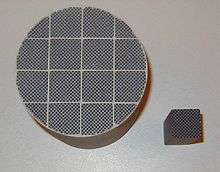Monolith (catalyst support)
A monolithic catalyst support is an extruded substrate widely used in vehicle catalytic converters.[1]
Properties

Monolithic catalyst supports are extruded substrates that are widely used in automotive and stationary emission control devices and other kind of reactors in the chemical industry. In automotive applications ceramic monoliths are made of synthetic cordierite, 2MgO*2Al2O3*5SiO2 which has a low thermal expansion coefficient.[1] A monolithic catalyst support consists of many parallel channels separated by thin walls that are coated with the catalytic active substance, most commonly a metal like platinum. The channels may be round or polygonal (mainly square or hexagonal). The structure is reminiscent of a honeycomb. The cell density may be from 30 to 200/cm2 with the separating walls from 0.05 to 0.3 mm. Because of a high open frontal area (the open spaces in the cross-sectional area) of 72 to 87% pressure loss of gases flowing through the structure is low, an important feature to minimize efficiency losses in vehicles.
Uses
- Automotive emission control
- Diesel particulate filters (DPF)
- Catalytic incineration
- Chemical process catalyst support
References
- 1 2 Williams, J.; Monolithic structures, materials, properties and uses; Catalysis Today, 69 (2001) 3-9